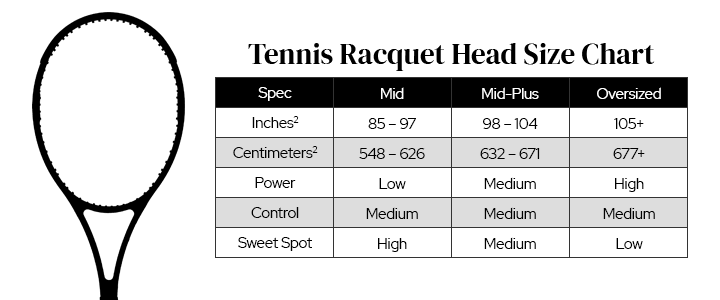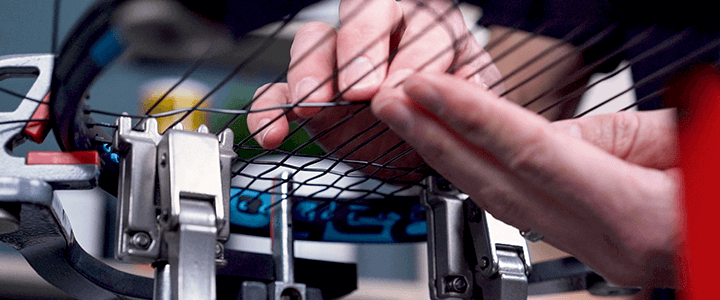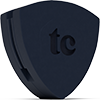Check out my custom vibration dampener
Tennis Racquet Head Size & Length
Guide + Charts
We hope you love this article. Just so you know, TennisCompanion may collect a small share of sales from the links on this page to help keep this site running. Learn more.
If you’re in the market for a new tennis racquet, then it can be helpful to learn how to select the correct head size and length, including how each of these variables impacts overall performance.
In this guide, we’ll review how each attribute is measured and provide easy-to-follow charts to help you decide which is best for you. We’ll also explain how variations in head size and length influence performance, the types of players who might benefit from different sizes, and discuss rules that players should consider.
Are you looking for how to select the correct size grip? Click here to jump to our guide on finding the perfect fit.
Article Contents
Click below to jump to a section
Tap below to jump to a section
Head Sizes & Performance
Head Size Chart
Head Size & Tension
Head Size Rules
Finding the Right Head Size
Racquet Length & Performance
Racquet Length Chart
Racquet Length Rules
Finding the Right Length
New to TennisCompanion?
Create a free account and explore my latest videos below
Tennis Racquet Head Sizes

The head size of a tennis racquet refers to the area of the racquet’s head where the strings create the face or stringbed, measured in square inches or centimeters.
These days, the vast majority of tennis racquets will have head sizes that range somewhere between 85 – 110 in² (548 – 710 cm²). The most popular head sizes used today are 97, 98, and 100 in².
There are three different categories for racquet head sizes, which roughly speaking coincide with the different types of tennis racquets.
| Head Size | Measurement | Type of Racquet |
| Mid | 85 – 97 in² | Control |
| Mid-plus | 98 – 104 in² | Tweener |
| Oversized | 105+ in² | Power |
For reference, here are a few examples of racquets that fit into each category.
| Racquet | Head Size |
| Head Graphene 360+ Prestige | Standard (93 in² / 600 cm²) |
| Head Graphene 360+ Prestige Pro | Standard (95 in² / 612.9 cm²) |
| Wilson Pro Staff RF97 Autograph | Standard (97 in² / 625.8 cm²) |
| Babolat Pure Strike 16×19 3rd Gen | Mid-plus (98 in² / 632.3 cm²) |
| Wilson Blade 98 16×19 v8 | Mid-plus (98 in² / 632.26 cm²) |
| Babolat Pure Aero 2019 | Mid-plus (100 in² / 645.2 cm²) |
| Babolat Boost Drive | Oversized (105 in². / 677.4 cm²) |
| Head Graphene 360+ Instinct Lite | Oversized (107 in² / 690.3 cm²) |
| Wilson Hyper Hammer | Oversized (110 in² / 709 cm²) |
A racquet’s head size is one of a handful of different attributes worth considering when buying a racquet, which impacts performance.
Let’s review how a racquet’s head size impacts performance.
Performance
When it comes to racquet head sizes, there are three primary considerations regarding performance:
- Power
- Hitting surface area
- Maneuverability
We’ll take a look at each of these individually.
Power
Generally, the larger the head size, the more power a racquet will offer. Conversely, a smaller head size will deliver less power, which translates to greater control.
An easy way to understand why this happens is to think of your racquet like a trampoline. The larger the trampoline, the more spring, and energy return you get, allowing you to bounce higher when jumping.
In other words, a larger racquet head will allow the ball to sink deeper into the tennis strings, resulting in a more significant rebound effect and, all other things being equal, more power.
As a racquet’s head size shrinks, the power potential shrinks along with it. Consequently, players will perceive a greater sense of control with a small racquet head because the racquet doesn’t generate as much power.
Even a small bump in a racquet’s head size from 98 to 100 in² (632 – 645 cm²) can provide a noticeable impact on a racquet’s power.
For example, in 2014, Roger Federer made a substantial shift in his tennis racquet’s head size, moving from 90 to 97 in² to help increase his power and margin for error. The change allowed him to remain competitive as the game of tennis evolved over the years.
Spin
Topspin is another area that a racquet’s head size can influence.
As the size of a racquet’s head increases, the strings typically end up spaced further apart, which allows them to enhance spin by embedding more deeply into the ball.
However, it’s worth noting that different racquets use varying string patterns, i.e., the number of vertical main and horizontal cross strings, so a larger head size doesn’t automatically guarantee enhanced spin.
For example, a 105 in² racquet’s 16×19 string pattern will be more open or have more space between the strings than a 95 in² racquet using the same pattern. Here are some of the most common string patterns.
| Pattern | Mains | Crosses |
| 16×18 | 16 | 18 |
| 16×19 | 16 | 19 |
| 16×20 | 16 | 20 |
| 18×19 | 18 | 19 |
| 18×20 | 18 | 20 |
The 16×19 pattern is by far the most prevalent, which you’ll find used across a wide variety of head sizes – larger and small.
Surface Area
Beyond power and spin, a racquet’s head size also directly impacts the hitting surface area of a racquet.
Larger racquet head sizes increase the surface area, which provides players with a higher margin for error when swinging to make contact with the ball. As a result, larger head sizes are ideal for beginners.
On the other hand, a smaller head size will provide players with less surface area, and ultimately, a lower margin for error when hitting and therefore require greater precision.
Furthermore, larger tennis racquet head sizes provide a more prominent sweet spot, a small area toward the center of the strings. When struck, it sends less shock to a player’s arm and hitting feels relatively effortless.

It’s common for athletes to describe a similar feeling in other sports, such as when swinging a golf club or baseball bat.
Maneuverability
All other things being equal, the larger a racquet’s head size, the more difficult it becomes to maneuver due to the extra mass at the top of the racquet and the minor addition of drag or wind resistance.
It’s common for manufacturers to combat this phenomenon by using lightweight materials and adding more weight to the handle for what we refer to as a head light balance.
When players are first learning, a highly maneuverable racquet can be beneficial because it makes it easier to learn proper technique. As a result, you’ll often find many racquets with larger head sizes that offer excellent maneuverability to cater to this audience.
Racquet Head Size Chart

When selecting a head size for your racquet, it’s a personal preference, so there’s no right or wrong answer. However, the size you choose will influence how your racquet performs.
With that in mind, the chart below illustrates how performance changes with the different head sizes that you might consider.
| Spec | Mid | Mid-plus | Oversized |
| Inches² | 85 – 97 | 98 – 104 | 105+ |
| Centimeters² | 548.4 – 625.8 | 632.3 – 671.0 | 677.4+ |
| Power | Low | Medium | High |
| Control | High | Medium | Low |
| Sweet Spot | Small | Medium | Large |
Keep in mind these generalizations tend to be true when comparing racquets where all else is equal.
Helpful Tip
When shopping for tennis racquets, you may find a reference to the racquet’s head size in its name. For example, if you come across the abbreviation MP in the name of a racquet, it’s referring to its mid-plus head size. Likewise, OS refers to oversized.
Head Size & String Tension

Tension impacts all head sizes the same way. That is, the lower the string tension, the higher a racquet’s power. Conversely, the higher the tension, the lower the power.
As a result, there aren’t specific rules for selecting a tension that applies to different size racquets. Instead, players should select a tension based on their racquet of choice, desired performance characteristics, and the type of string they’re using.
For more information on the topic, be sure to check out our in-depth guide on string tension.
Head Size Rules

The official rules of tennis state that a racquet should not exceed 12.5 inches (31.75 centimeters) in width overall. Moreover, the hitting surface cannot exceed 15.5 inches (39.37 centimeters) in length and 11.5 inches (29.21 centimeters) in width.
These measurements are generous, so you’ll find the vast majority of tennis racquets available for purchase fall into these acceptable ranges. As a result, there’s no need to worry about violating these rules. Of course, even if you find a racquet that falls outside these ranges, it only matters if you plan to play competitively.
Finding the Right Head Size

There’s no right or wrong answer to which head size you should be using as a tennis player. However, some recommendations will tend to suit specific levels of play.
Ideal Head Size for Beginners
Understanding which head size to buy is a common question newcomers have when selecting a new tennis racquet.
Ultimately, it boils down to personal preference. However, most beginners will benefit from larger head sizes that increase the surface area of the strings, improve margin for error, and enhance power.
More specifically, we generally recommend players opt for a racquet that is at least 100 in² (645 cm²). Typically, we find players have more fun learning how to play tennis with these head sizes.
If you’re just getting started and looking for a new racquet, be sure to check out our list of the best tennis racquets for beginners. All of the racquets on our list have head sizes that align with our recommendation.
Intermediate & Advanced Head Sizes
Often, experienced players who have developed solid form and technique will benefit from the increased control associated with smaller head sizes.
However, as tennis has evolved, more of the game’s top players have opted for mid-plus size racquets that enhance power and spin while still providing adequate control.
Roger Federer’s use of different head sizes throughout his career paints an excellent picture of how his racquet has evolved to keep up with the changing game. In 2002, he moved away from his smaller 85 in² head size to 90 in². Then in 2014, he made another significant leap switching to 97 in².
Our recommended head sizes for intermediate to advanced players range from 97 in² ( 625.805 cm²) to 100 in² (645.16 cm²).
At these levels, players will benefit from considering their style of play as they identify the best tennis racquet and head size for their needs.
Tennis Racquet Length

The length of a tennis racquet is another characteristic that varies between frames. Most tennis racquets range from 27 (68.58 centimeters) to 29 inches (73.66 centimeters) in length.
The standard length for an adult tennis racquet is 27 inches or 68.58 centimeters. We refer to anything longer as extended length.
Performance
When evaluating racquets, four topics usually come up:
- Reach
- Maneuverability
- Power
- Spin
Let’s dig into each.
Reach
The first and likely most obvious factor is that a longer racquet will provide a player with more reach – that is, the ability to hit a ball that is farther away from their body.
A small change in length can be the difference between a player getting to a tennis ball or not.
Maneuverability
Closely related to reach is maneuverability. Typically, the longer the racquet, the more difficult it can be to maneuver.
In particular, shots close to a player’s body can be more challenging to hit with an extended frame, and players may not be as quick to adjust their racquet when hitting balls requiring fast reflexes such as volleys or returns.
However, it’s worth noting that extended-length racquets aren’t automatically drastically more challenging to maneuver.
Racquet manufacturers recognize how length impacts maneuverability, so they’ll adjust other specs such as weight and the balance of a racquet’s weight to accommodate.
Power
A longer racquet will also provide players with more leverage or the ability to achieve greater force when striking a tennis ball, which helps increase the power of the tennis racquet.
Many players will find the extra length advantageous when serving, as it allows them to hit a bigger, faster serve. Similarly, racquet head speed will increase on other strokes as well.
Spin
Similar to power, the potential for spin will increase as the length of a racquet does. That’s because length influences racquet head speed, which has a direct and significant influence on spin.
Of course, other factors like a player’s grip, type of string, and technique will also contribute to topspin.
Racquet Length Chart

Up until roughly their teens, a child’s height will directly influence the appropriate racquet length.
For adults, it’s all about personal preference, but it’s rare for adults to use racquets that are smaller than 27 inches in length.
Here’s a chart to help illustrate how age and height influence the ideal length racquet for children and adults.
| Age | Height | Racquet Length |
| 4 years or younger | 40 inches or shorter | 19 inches |
| 4-5 years | 40-44 inches | 21 inches |
| 6-8 years | 45-49 inches | 23 inches |
| 9-10 years | 50-55 inches | 25 inches |
| 10 or older | 55 inches or taller | 26 inches |
| Adults | Any height | 27-29 inches |
It’s worth noting that the quality of tennis racquet also comes into play with regard to length. Typically, manufacturers make smaller kids tennis racquets from inexpensive materials such as aluminum and feature low-end construction methods.
Top tennis brands like Wilson, Babolat, and Head typically reserve high-end materials and construction techniques for racquets 27 inches (68.58 centimeters) or longer.
Racquet Length Rules

Currently, 29 inches (73.66 cm) is the maximum length allowed for competitive play under the official rules of tennis.
As mentioned earlier, the standard length for a tennis racquet is 27 inches or 68.58 centimeters. As such, you’ll find the vast majority of adult tennis racquets with this length. Extended length racquets are most commonly a half-inch longer at 27.5 inches or 69.85 centimeters.
Racquets that are shorter than 27 inches are ideal for children whose development hasn’t progress to the point where they can comfortably use the standard length.
Finding the Right Length

For most adults, we recommend starting with a 27 inch (68.58 centimeters) frame, as it’s usually a sufficient starting point, and you’ll likely never need to adjust from that length.
Furthermore, the majority of tennis racquets on the market are 27 inches (68.58 centimeters), so you’ll have the most options, and if you switch racquets, it will be one fewer criteria to consider.
However, don’t let that deter you from trying a racquet with extended length, which can help enhance your game.
Extended-length tennis racquets also make great options for shorter players looking for extra reach, power, and spin.
Head Sizes & Lengths the Pros Use
Curious what head sizes some of the top pros on the ATP and WTA tour are using? The following chart explores some of the players that frequently come up in conversation.
ATP
| Player | Head Size | Racquet Length |
| Roger Federer | 97 in² (626 cm²) | 27 in (69 cm) |
| Rafael Nadal | 100 in² (645 cm²) | 27 in (69 cm) |
| Novak Djokovic | 95 in² (613 cm²) | 27 in (69 cm) |
| Andy Murray | 98 in² (632 cm²) | 27 in (69 cm) |
| Daniil Medvedev | 95 in² (613 cm²) | 27 in (69 cm) |
| Dominic Thiem | 98 in² (632 cm²) | 27 in (69 cm) |
| Stefanos Tsitsipas | 98 in² (632 cm²) | 27 in (69 cm) |
| Alexander Zverev | 100 in² (645 cm²) | 27 in (69 cm) |
| Andrey Rublev | 100 in² (645 cm²) | 27 in (69 cm) |
| Grigor Dimitrov | 97 in² (626 cm²) | 27 in (69 cm) |
WTA
| Player | Head Size | Racquet Length |
| Serena Williams | 104 in² (671 cm²) | 27 in (69 cm) |
| Venus Williams | 104 in² (671 cm²) | 27 in (69 cm) |
| Simona Halep | 99 in² (639 cm²) | 27 in (69 cm) |
| Ashleigh Barty | 100 in² (645 cm²) | 27 in (69 cm) |
| Naomi Osaka | 99 in² (639 cm²) | 27 in (69 cm) |
| Iga Swiatek | 100 in² (645 cm²) | 27 in (69 cm) |
| Bianca Andreescu | 95 in² (613 cm²) | 27 in (69 cm) |
| Karolina Pliskova | 100 in² (645 cm²) | 27 in (69 cm) |
| Coco Gauff | 100 in² (645 cm²) | 27 in (69 cm) |
| Garbine Muguruza | 100 in² (645 cm²) | 27 in (69 cm) |
Please note that we’ve rounded the centimeter measurements in the tables above to make it easier to read.
Wrapping Up
If you’re looking to determine the best head size and length for yourself, first start by evaluating the pros and cons in this guide.
Most players will do great with a head size in the range of 98 (632.26 centimeters) to 105 in² (677.42 cm²) and a length of 27 inches (68.58 centimeters).
As with most decisions for tennis gear, nothing beats getting on the court with a racquet you’re interested in and testing it out for yourself.
Many racquet shops, clubs, and online retailers offer demo programs where you can spend some time with a racquet before purchasing it, which we’d highly recommend.
Do you still have questions about what racquet head size or length might be best for you? Feel free to ask a question or comment below, and we’ll be happy to help!
Play Better Tennis
Improve your game alongside our community of tennis players
Why join?
Discussion Boards
Join the conversation with other members of the community.
5 Point Friday
Read our weekly recap of the 5 most interesting things we dig up in tennis.
Trackbacks & Pingbacks
Leave a Reply
Want to join the discussion?Feel free to contribute!



Hello guys , I measure 1M98cm and i’m playing with a babolat pure drive , I’m willing to change this racket because i think that one is too short for me . So what’ll be the best racket lenght for me
thank you :D
Hey Jamil,
Thanks for your question. Do you mind telling me what problems you’re experiencing with your Babolat Pure Drive? Are you looking for more power, control, reach, etc…?
The standard length Pure Drive is a 27 inch racquet, which is a very common length so it’s likely you may be able to solve any issues you are experiencing without changing the length of your racquet.
For comparison, John Isner one of the taller players on the ATP tour uses a 27 inch racquet and he’s 6’9″ or just over 2M tall. Of course, every player is different, but I find it’s less common that the length of the racquet is the direct cause of problems for players.
Looking forward to your reply!
All the best,
Jon
Note John isner now use an extended racquet – that is 27.5
Thanks for the note on that update, Lars – much appreciated.
In your post, there is not discussing about grip size and type, can you please do it more clearly? thank for your helping.
Hi Lee,
Thanks for stopping by! Check out this article on grip sizes to learn everything you need to know about selecting the perfect size for your racquet.
Of course, if you have any follow up questions or need any clarification – just let me know.
Cheers!
Jon
hello good day, i just want to ask what is the standard racquet for the beginners like me? thank you.
Hi Jay,
Excellent question – finding the right racquet for beginners can be tricky. There are a lot of options :)
I wrote this post to help beginners find a great racquet, and I think it will help point you in the right direction.
Of course, if you have any questions about it, please don’t hesitate to ask. I’d love to help out!
Until then, have a great day!!
All the best,
Jon
Hi,I am a new player,just started,
What are the differences between 99in and 100in?
Can I start with 99in?
Thanks
Hi Miltos – thanks for your question.
Assuming you’re looking at the same racquet (one with a 99 and the other with 100 in²), then the difference will be minor as it’s not a significant change in size.
With that said, the 100 in² version should have a little extra power. Outside of that, I wouldn’t expect much difference. If you can share the exact racquets you’re looking at, I’d be happy to get more specific for you.
All the best,
Jon
I have been using Wilson Ncode N2 which has a large head but has been discontinued. Any idea of equivalent substitute?
Hi Ratanlal,
Check out the Wilson K Factor KZero. The head size is a little smaller, but you’ll find it shares many of the same attributes as the Wilson Ncode N2. Have you come across it?
Good luck in your search.
All the best,
Jon
Hi I have just taken up tennis . I am 4ft10″ tall. Aged 64, female. I find the 27″ length racket I have brushes the floor when trying to serve. Should I go for a junior 26″ ?
Hi Shan,
Moving down a size in your racquet is absolutely an option. However, the only challenge you may find is that your selection will be mostly limited to junior tennis racquets. If you’re a recreational player that’s not overly concerned with racquet performance, then this would be a reasonable option.
One exception would be Tecnifibre’s T-Rebound line of tennis racquets, which are 26.5 inches in length. Perhaps that’s enough to make the difference for you.
Aside from that, you may want to take a look at your technique when hitting your serve. Even at 4’10,” I’d expect this shouldn’t be an issue for you, so linking up with a local instructor would also be worth the effort.
Good luck and let me know if there’s anything else I can do to help.
All the best,
Jon
Can anyone tell if head racquet size of 125 square inches can be used in USTA junior girls tournament?
Hi Julian,
There’s a good chance that racquet head size is too large for competition. If you can share the specific model, I can check out the specs and double-check for you.
Here’s the section of the article you’d want to refer to if you’d like to take some measurements yourself.
All the best,
Jon
Hi there, My 17 year old son is having some issues with his shoulder – it keeps popping out when he serves (currently being investigated by doctor) I need to buy him a new racquet. Any suggestions? Any help much appreciated. R
Hi Raelynn,
Ouch – that sounds troublesome. Sorry to hear about that.
I’d be happy to provide a few recommendations. As a starting point, it would be helpful to know which racquet your son is currently using. Answers to these questions would help too:
I’ll keep an eye out for your reply.
All the best,
Jon
Hello – I am just starting to take up tennis again but have a question. I played before with two good eyesbut now I am losing sight in my left eye. I am right handed and now I am having trouble hitting the ball and even missing it on a regular basis. I believe Iwould benefit from a larger racket as I now am using one that is 115 square inched. Would you agree with that?
Please let me know your thoughts
Thanks
Bob Scott
Hi Bob,
I’d agree with your thoughts. Increasing your racquet’s head size will afford you a larger margin for error, so it sounds like a great idea.
All the best,
Jon
Hello,
My girlfriend is fairly petite and she finds the standard length tennis rackets to be too heavy and the grip be too big for her small hands. She’s about 5’1 and 100 lbs. what length/weight/grip size racquet would you suggest would fit her appropriately/comfortably? Thanks in advance.
Hi Austin,
Thanks for stopping by – great question.
My first suggestion would be to make sure she’s had the opportunity to try a lightweight tennis racquet that’s full-size as some are surprisingly light and still could be a good fit. Also, making sure that she’s tried a size #0 or 4-inch grip, which is the smallest for these racquets. For some options, check out my article on tennis racquet weight and balance.
Another lightweight option that’s also affordable is the Babolat Boost Aero or Babolat Boost Drive.
If she finds the weight of a full-size tennis racquet she likes, but the #0 or 4-inch grip size is too large, then one last-ditch option would be to replace the grip with something thinner.
If she finds these to be tricky to handle and the grip size is too large still, then she can drop down to a smaller junior size racquet, but the build quality will begin to vary.
You have two buckets of junior racquets:
– Premium
– Inexpensive
Premium Junior racquets will have mid-range prices and offer better performance in 26 and 25-inch lengths. However, one of the challenges you might find with these is that they’ll typically offer a size #0 or 4-inch grip. Here are two examples:
– Babolat Pure Drive Junior 26″
– Wilson Clash Junior 26″
However, if she found the size zero grip size too large in full-size 27-inch racquets, then you might need to drop down an inexpensive junior racquet. Inexpensive Junior racquets will drop well below $50 and have the smallest grip sizes of them all, but they lack build quality – here are two examples:
– Babolat Nadal Junior 26″
– Wilson Junior Racquet
If she’s looking to play casually and for a little bit of exercise and not taking it too seriously, then a junior racquet could work just fine for her. However, if she’s taking it more seriously, I’d encourage her to experiment and exhaust some of her options of full-size racquets.
I hope that helps!
All the best,
Jon